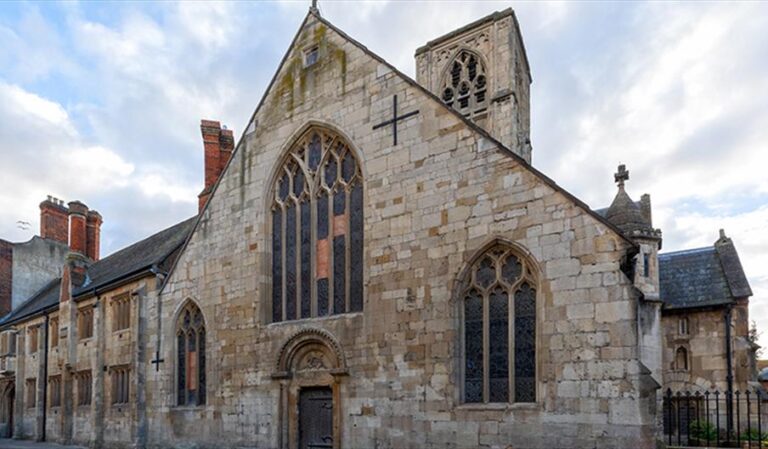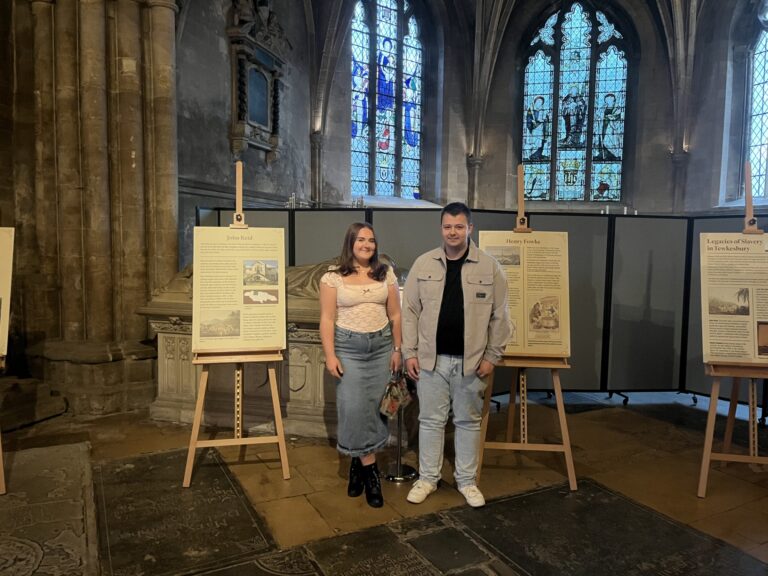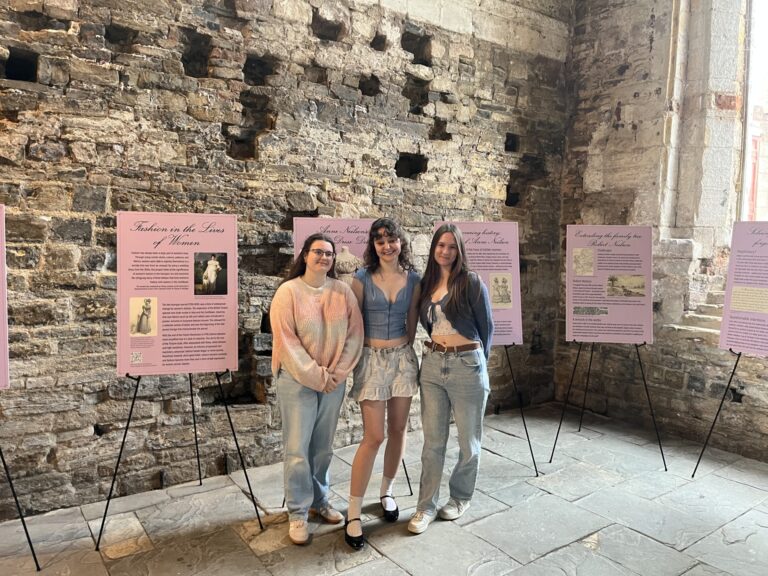| CC4HH
‘Cheltenham Lower High Street: Past, Present and Future’
This project is a research project initiated and led by staff members at the University of Gloucestershire in collaboration with the Cheltenham West End Partnership and the Cheltenham Civic Society. This project places Cheltenham’s Lower High Street in its historical context and examines its past, present and future.
Jump to: Context, aims and funding | The exhibition | The film | The interviews | Get involved
Cheltenham’s Lower High Street (LHS) region is one of the oldest areas of the town, with its history dating much further back than the Regency period, when most of the now historically and culturally significant parts of the town centre were constructed; the LHS area also has a distinctly non-Regency appearance, unlike many of the wealthier streets on its borders.
The LHS has recently been the focus of a number of regeneration and renewal projects and has proved itself to be stubbornly resistant to Council-sponsored attempts to impose a form a Suffolks-style ‘gentrification’ in the neighbourhood: why is this the case? Likewise, we know very little about local resident and trader responses to the on-going ‘studentification’ of the area surrounding the University of Gloucestershire’s Francis Close Hall campus as student numbers have grown over the past two decades in relation to the expansion of enrolments in Higher Education.
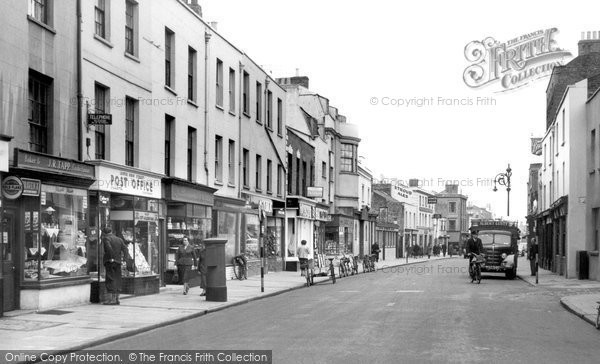
The primary aim of the project was to produce an exhibition on the history of the area and a short documentary film at Cheltenham’s Civic Day on Saturday 17 June 2017. To do this, project researchers identified and collated from diverse collections and publications the range of primary source materials already available for the study of the LHS, as well as locating and sourcing new materials not used by previous researchers.
Researchers focused primarily on oral history interviews with former and existing residents to bring the memories and experiences from life in the area to the fore.
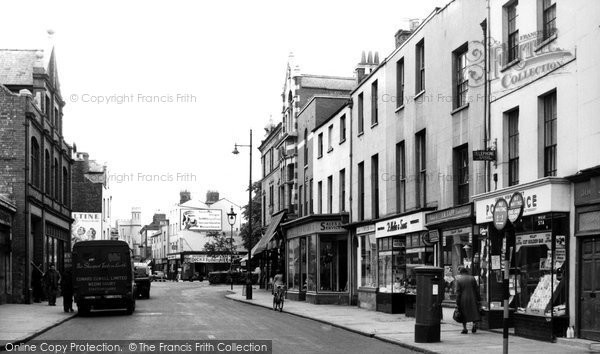
The aim of the project is to challenge two main characteristics of the Lower High Street’s history. The first is the area’s almost complete exclusion from more established histories of Cheltenham which have tended to prioritize and celebrate the town’s rich Regency heritage over it’s working class history. The second is to challenge the negative stigmatization of the area by highlighting the area’s importance in Cheltenham’s development, primarily by acknowledging and understanding the experiences of people who lived and grew up there. The project team is still conducting interviews and building a publicly available archive of oral testimonies. It is hoped that a more sensitive understanding of the past can positively influence redevelopment plans.
Find more details about the project researchers and their areas of expertise.
We are always interested to hear the thoughts and responses of people of who see the film and the research done on the Lower High Street. We would be grateful if you could spend a few minutes completing our survey:
This project was made possible by two generous grants:
- Funds from the University of Gloucestershire’s Learning Innovation for Tomorrow (LIFT) scheme, which is geared to bringing transformative, futures-oriented learning into the curriculum, co-curriculum and education support. This money has been used to support the Level 5 group project work.
- Funds from the University of Gloucestershire’s Being Human Research Priority Area, which was established to address areas of research that are concerned with human experience and a sense of heritage and direction. This money has been used to run a parallel series of staff and postgraduate projects.
The exhibition
The Lower High Street is home to some of the most interesting stories in the area. During 2016 and 2017, our researchers focused on recording memories from people who lived and worked in the community. Exploring aspects of life from shops to spirituality, from butchers to back street boxing bouts, our exhibition, held at Chapel Arts 17-30 June 2017 and between 28 November 2017 and 10 December 2017, told the hidden histories of the Lower High Street and looked to protect and conserve those memories before they are lost. To find out more about the event, check out our Facebook page.


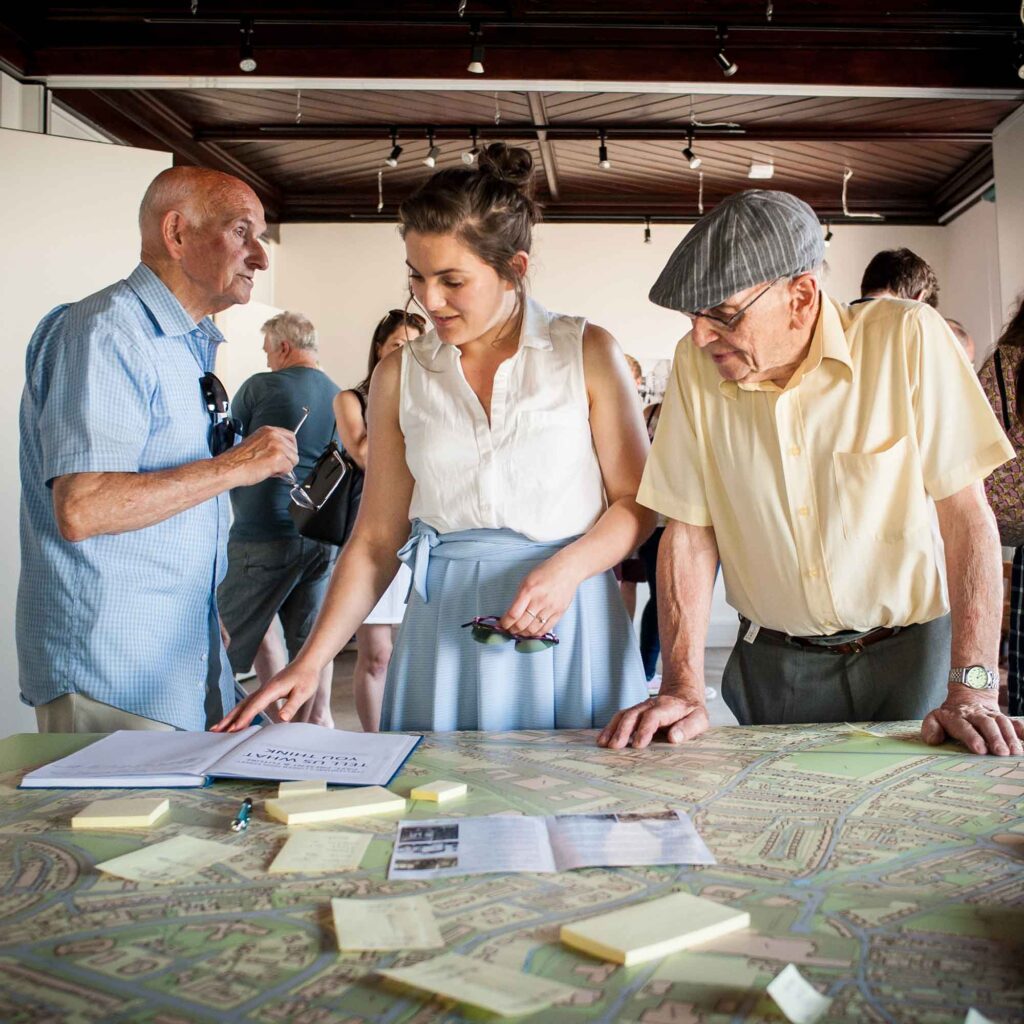

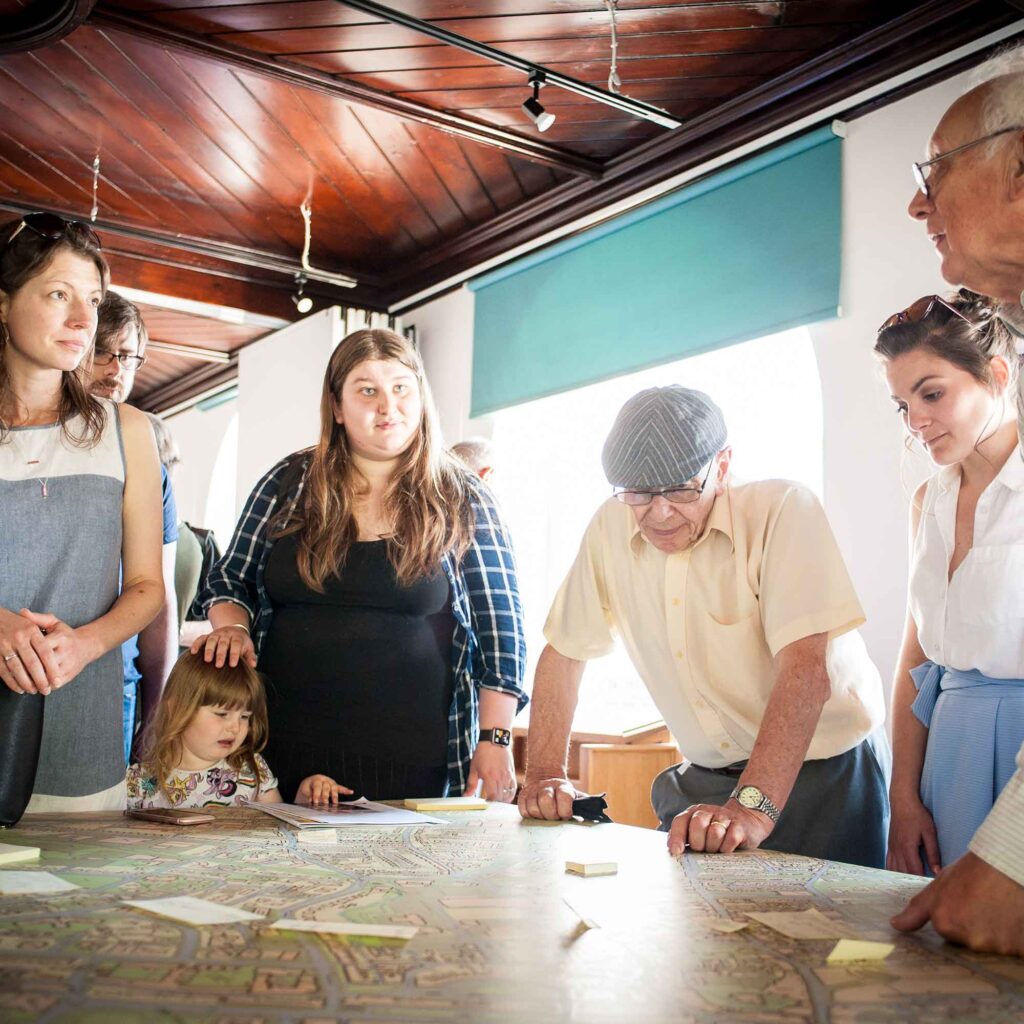



If you were unable to make it to the exhibition, you can take a virtual tour by opening each section below.
Welcome to the Cheltenham Lower High Street project. What you are about to see is a start and not the end. Over the past six months, staff and students from the history team at the University of Gloucestershire have been working day and night, to record and conserve the memories of the Lower High Street. Our research will continue long beyond this exhibition, and we want you to be part of it. But why record memories, you might ask? As historians, we could easily just focus on maps and archives, old newspapers and census reports. For a long time though, the Lower High Street has been overlooked by researchers, so the way we look at the history of this area needs to be a little different.
Memories give us something unique. Everyone remembers people and places differently, and they remember different things. By speaking to people, and recording their reflections, we can get a much deeper sense for what life in the Lower High Street was like for residents. We can also develop a strong sense for how a place has changed, and how people feel about that change.
This exhibition explores the earliest origins of the Lower High Street, through to the modern day. We wanted to chart how the Lower High Street has evolved, and how people feel about those changes. Depending on who you ask, you get some very different stories. Be it buying supper from the wet fish shop, or visiting the pubs on every corner, to friendly familiar faces in store front doors, or avoiding the bare-knuckle boxing in the back alleys, everyone has a story to tell, and every story is different.
However, we know only too well that we have recorded only a tiny portion of the available memories of the Lower High Street. That is why we need you. Throughout this exhibition, you will see many questions, and have the opportunity to add your own memories and reflections. We don’t want you to just visit this exhibition, we want you to be part of it, and make it grow.
As much as possible, we have tried to let the Lower High Street speak for itself. A place is its people, and that is no different for the Lower High Street. Throughout this exhibition, you will find snap shots and soundbites from interviews that we have conducted with former and existing residents of the area. It is through their memories that we have explored the history of the Lower High Street. Arguably, it is through their memories that the Lower High Street survives. The question facing everyone in Cheltenham today, is how do we safeguard what remains of the Lower High Street, remembered so fondly by so many people?
We would like to thank everyone who has opened their doors to us and given their time so far. Special thanks go to Chapel Arts for being our kind and generous hosts, and to the Cheltenham Civic Society for their support and enthusiasm in this project.
Before the turn of the nineteenth century, Cheltenham consisted of no more than a High Street and a few lanes and alleys. After King George II’s visit to the town in 1788, however, Cheltenham’s popularity as a tourist destination grew rapidly. Over the next fifty years, the town dramatically expanded and the population grew. As Cheltenham changed, lavish villas and luxury shops were established in streets adjoining the High Street. Cheltenham gradually became a town of ‘shady promenades’, ‘stately mansions’ and ‘elegant villas.
As the town’s popularity rose, the population changed. Farm labourers, domestic servants and Irish immigrants were among those who came to the town looking for work. Most new arrivals settled in the ‘lower end of the town, along what became known as the Lower High Street. By the end of the Victorian period, the Lower High Street district, with its narrow streets, its overcrowded lodging houses, its countless shops and pubs, and its small cottages, had become almost a town unto itself.
The eastern end of the Lower High Street came to mark an invisible yet well-understood social boundary that separated it from Cheltenham’s wealthier areas. The contrast between wealth and poverty was acknowledged by members of the town’s political, religious and economic elites, who sought to improve the well-being of the area. This included opening a ‘Ragged School’ in Milsom Street in 1864. The school provided education, food and clothing to hundreds of children whose parents could not afford to pay school fees. The school taught shoemaking and tailoring to boys and needlework and laundry to girls. It was taken over by the local education authority in 1904.
During the same period, the Lower High Street acquired a reputation for vice and immorality. This attracted the attention
of evangelists from outside the area. Several churches and chapels had been established in the district by the end of the nineteenth century. However, inhabitants of the ‘lower end’ of town were criticised in the local press for failing to attend religious services. Some preachers adopted unconventional methods to share the gospel. William Mortlock and his daughter Annie organised Sunday evening services in workers’ homes and, in the mid-1890s, established a ‘mission room’ where working men and their families could read books, watch musical concerts, eat faggot suppers and, on Sunday evenings, receive religious instruction.
Many of the homes that Mortlock and his daughter visited were full of ‘dirt and despair. In the 1930s, government plans to abolish ‘slum’ housing spurred local authorities into action, and several houses, including cottages, back-to-backs’ and shops in Grove Street, Burton Street and Milsom Street, were marked for demolition. While the aim of the slum clearance programme was to improve the health and well-being of the town’s population, its immediate effect, as one sympathetic Town Councillor noted, was to deprive poor people of what may have been their only possession.
Sat by the fire, I was thinking one day,
Of Cheltenham, a long time ago.
No housing estates and no shopping arcades,
And the tempo of living was slow.
Right at the far end of town, were the shops
I remember when I was a mite,
Miss Nealon’s, the toyshop, where 6d was spent
Or threepence – when money was tight.
Dinky Dave’s sweetshop was over the road,
A pennorth of scrapings was grand
And a shop further down than sold bottles of pop
For, the penny, clutched in your hand
Mrs Trapp’s hot dog pies that were scrumptious to eat
The gravy ran all down your chin,
And the faggors and chitterlings from Whittings we bought,
Were so good that they’d make your heart sing.
We brought all our cycles at Hamlyn’s,
And at Christmas to Martins we went,
To buy bottles of beer and get our Christmas cheer,
As our Christmas club money was spent.
‘Dick the Butcher’ was good for a chop or a steak,
Mrs Green served our grocery needs,
Dimery’s & Davis’s dished up the spuds,
Mrs Iddles supplied ‘fishy needs’
Bloodworths for bread and Boots for our pills,
Mr Cousins who mended our shoes.
And for sixpence or so, to the Ritz we could go,
For a film and an update of news.
The Kings Head and The Oak for a pint and a joke
Tommy Coole for our buckets and mops.
The Mission for hymns and repent of our sins,
The to Dick’s for ribbons and socks.
A barber was there, trimming heads with great care,
And a shop that sold wigs and false hair,
Animal feeds and all your pet needs,
On the corner of King Street stood there.
For the travellers the Wembley provided a bed,
For the hungry a drink and a meal,
A herbalist’s shop, with mysterious stock,
Who claimed all your ailments he’d heal.
There’s probably dozens of shops I’ve left out,
I could go on forever I swear,
But that end of town, was a world on its’ own,
And whatever you wanted was there.
We all knew each other, husbands, wives, sons and mothers,
Your sorrows and joys were shared
And to shop was a pleasure you did at your leisure,
When shopkeepers and customers cared.
Do you know?
This poem was sent to us anonymously. After several months, we still don’t know where it came from or who wrote it.
Do you know who put this poem together?
Can you shed any light on the mystery of the Lower High Street poem?
Today, the Lower High Street is full of clues about its past. The street is currently home to many different types of businesses. If you look closely, lots of the buildings retain the wooden frames, large windows and paved entrances that characterized the family-owned businesses of the area. Based on interviews with residents, this was a distinctive characteristic of the area. It seems these businesses enjoyed prosperous times. The Lower High Street thrived, particularly in the post-WWII years. This would all change with the arrival of large supermarkets around Cheltenham, in the late 1960s.
- “Everything was there that we needed, rather than going ‘up town”. (40s/50s)
- “if you didn’t have much money, like most of the people in Lower Dockham, you’d got a ha’penny, you went in the back room and had just peas and the gravy.” (1930s)
- “you had the bake house that my uncle used to work at, where I spent many happy weekends scoffing jam tarts and eating pies.” (1940s)
- “The Essoldo was the first cinema in Cheltenham to have Cinema-Scope” (1950s)
- “There were five butchers’ shops from the bowling green down to the bottom, at the end. So you had plenty of choice if you wanted meat” (1950s/60s)”
- “The people in the shops cared about the people that lived around them. It was a community in its own right.” (1940s/50s)
- “In those days, there were no supermarkets. If you wanted a loaf of bread, you went
across the road to Gardners; if you wanted a pound of sausages, you went out to
the butcher’s, either the one opposite or the one down the road. And that’s the
thing… and everybody knew me, and everybody knew each other.” (1950s/60s) - “we didn’t go up the Prom a lot when I was little because you had everything you
wanted in the High Street.” (1950s/60s) - “But in the 60s, things started to change, and people slowly disappeared” (1960s)
- “I remember when Tesco opened at the bottom of the high street, the shops started
to shut.” (1960s) - “by the end of the 60s, I think, that was when…the Lower High Street…went into
decline. It was partly because of the loss of community and different things took over, that you wouldn’t recognise it if you’d seen it now, compared to what it was when I was even a teenager in the 60s.” (1960s) - “It stayed as it was for quite a while, and then they started to say some of the houses needed to be pulled down… there was a lot of…”We don’t want to move from our house.” They’d been there for years.” (1960s)
- “I thought it improved quite a bit. You still had the old folks who stayed static
and stayed in the same class as you put it that way, but I’m pretty sure people’s lives improved. It’s still quite a rough town now.” (1960s) - “the transport system has killed it really now, to be honest. It’s killed that
area… A lot of character shops went when they did that.” (1970s/80s)
Do you remember?
We’ve heard about so many different shops on the Lower High Street while conducting our research.
Who remembers buying dinner from the ‘wet fish’ shop, or playing in the arcade?
We’ve probably only scratched the surface in tracing all of the historic shops of the Lower High Street – what do you remember that we might have missed?
“But that end of town, was a world on its’ own…
….Your sorrows and joys were shared”
The Lower High Street rarely features in published histories of Cheltenham. Usually research has focused on Cheltenham’s development as a Regency town. In Cheltenham Historical Walks the area is described as housing the ‘Lower Orders. People came from the countryside looking for work in the early 19th century, which led to new streets being laid out either side of the High Street. It can be argued that the area’s reputation for housing the Lower Orders’ lingers today. Yet, the memories of those who lived and worked in the area throughout the 20th century paint a positive picture of a close- knit community that thrived despite difficult conditions.
- “it was a very self-centred little life. We all got on.” (1930/40s)
- “if anyone hurt themselves.. if someone saw someone hurt, they would be there. And if they’d got a pinafore, off came the pinafore to bandage up or tighten up or something. Oh gosh, yeah [there was a sense of community]. Everybody knew everybody.” (1930/40s)
- “if you worked, you just worked in Cheltenham, or you worked on the railway, or you worked in the coal yard, or you worked on the gas works. And everybody in the allotments all knew each other, and they helped each other.” (1930s/40s)
- “The Lower High Street really supplied and helped everybody from that end of town, which included Dockem. If people would come in and say, ‘Oh, can I pay you for this next week?’ people would do that.” (1950/60s)
- “The shops down there, everybody knew everybody else. It was a community of its own and you could get everything if you wished to live and to do anything else with your life..” (1950/60s)
- “when I was younger, rationing was still on, and there was a lot of scarcity of lots of things. I can remember Mrs Pritchard making me an overcoat out of somebody’s jacket, an adult jacket.” (1950s)
- “I mean, as far as a childhood was concerned, we could go out in the street and play, no cars, and that was it.” (1930/40s)
- “we all played in the street. I think there was one car in the street.” (1940/50s)
- “I remember that it was like our playground, because there was hardly any traffic around… we used to play on the lorries, on the backs of the lorries.” (50s/60s)
- “I wouldn’t have lived anywhere else.” (1930/40s)
- “My childhood was great. I came from a pretty poor family I suppose and we
did progress to get a little bit out of the doldrums but generally we were okay. We did okay.” (1940s/50s)
Do you remember?
Do you remember growing up in and around the Lower High Street?
Do you remember playing in the streets?
Was it as safe and friendly as some people remember?
The small terraced houses that line the streets around the Lower High Street stand in stark contrast to the large Georgian townhouses and villas of ‘Regency’ Cheltenham. They tell the story of the predominantly working- class heritage of the area. Many of these small cottages were demolished in ‘slum’ clearances during the early 20th century. However, these homes and their label as ‘slums’ indicate that the way people living in the area were perceived negatively.
During our interviews, residents remembered the Promenade as a clear divide between this area and other parts of the town. The recollections of residents confirm that the Lower High Street was very poor. However, the lack of material wealth was not a barrier to creating fond memories. The sense of nostalgia evoked by these memories may seem strange in the light of the poverty that characterised the area.
Do you remember?
Is this the Lower High Street you remember?
Or, is this all a bit nostalgic?
Everyone remembers things differently, and one person’s paradise can be another person’s pain.
What was good about the life on the Lower High Street?
What were the challenges faced?
In 1895, the Cheltenham Chronicle reported on efforts to establish a temperance club in Sun Street. Was this response to alcohol consumption really needed, or just based on rumours and reputation? If it was reputation, the Lower High Street certainly earned it. Almost all of our interviewees highlighted the huge number of pubs on the Lower High Street. We also learned about the popularity of bare knuckle boxing, where bouts would regularly be arranged in pubs and ‘out back. What does this tell us about the Lower High Street? Was alcoholism and violence a major problem? Or, was the Lower High Street full of pubs, because the area was so busy and popular with workers in the area?
- “…very safe. You could’ve gone out any time of night and never have closed up your door. Nobody ever locked their door.” (1930/40s)
- “it was great. It was a lovely place to live really. You’d get a few little bust ups, but not so much at our end. Not very many at all, anyway, and the next day they’d be friends again.” (1930/40s)
- “You always respected everybody else. I’m not saying we didn’t… You know where Brunswick Street is up here? Yeah, well Brunswick Street was the roughest, toughest area.” (1930s)
- “I have memories of running up and down the street and playing and having just a great time. Nobody locked their doors.” (1940s/50s)
- “I remember some of the fights when I was younger. I didn’t start doing them until I got a bit older in my teens. I was involved quite a bit, even later on in my teens. Not when I was small. I can remember fights in the street.” (1940s/50s)
Do you remember?
Can you name all the pubs on the Lower High Street?
Did you use to live in one of the many ale houses found on the street?
Do you have any stories about the fighting which took place in bars and back alleys?
Is there any truth to the rumour of a world champion bare knuckle boxer running a pub on the Lower High Street?
‘No housing estates and no shopping arcades, and the tempo of living was slow…’
The biggest challenge in researching the Lower High Street, was deciding where it begins and ends. Interviews with former and existing residents revealed many different opinions on the exact location of the area known as the Lower High Street, and what it was actually called. Should we be speaking about the Lower High Street, the West End, or Lower Dockem? One of the most divisive debates centred on ‘Lower Dockem. Was this area between Henrietta Street and Gloucester Road? Or, was ‘Lower Dockem’ the area of St. Peter’s parish north of Tewkesbury Road, described by John Goding in 1863 as a place where ‘people of respect are afraid to live… Persons are stoned and pelted
with mud… [and where] one or two have lost their lives? A very different story is told in the Cheltenham Chronicle on May 4th 1940 however, where an esteemed person describes their preference for walking along ‘Dockem’ rather than going to church on a Sunday.
- “Lower Dockem is from about the bowling green by St George’s Street”
- “As far as I was concerned, Dockem went as far as the gas works. That’s what we always thought was Dockem, wasn’t it?” (1930s)
- “As far as we were concerned, it started from where the bowling green was… it carried on right the way down to Moors Avenue, down into Tewkesbury Road… It was all Lower Dockem” (1930s/40s)
- “In my opinion, Dockem started at the gas works… the pepper box, Dick’s Corner, down to the other side of the railway bridge, that was the Lower High Street. Of course then you get to Tewkesbury Road, which is Dockem. That’s how I always understood it.” (1940s/50s)
- “Dockem would never go up as far as Ambrose Street, to be honest with you. I think that’s a bit of a fallacy, because the slums did start literally from White Hart Street all the way down…. That was even poorer than where the shops were… The shops weren’t known as Dockem. They weren’t known as part of Dockem. The shops supported Dockem.” (1940s/50s)
- “We always regarded the Lower High Street, from what they called Foster’s Corner, the corner of St George’s Street down. Now it’s classed from Primark down.” (1950s/60s)
- “We will always often call it Lower Dockem.” (1950s/60s)
Do you agree?
Where do you think the Lower High Street begins and ends?
Do you remember or recognise Lower Dockem?
Is Dockem the same as the Lower High Street, or something totally distinctive?
Today, the Lower High Street is subject to significant change. For many people invested in the area, that change is not always for the better. For someone who lived on the Lower High Street in the 1900s, the area might now be unrecognisable. However, there is still a positive story of diversity to be found. The Lower High Street has seen the impact of studentification, as shops change to accommodate the needs of students. Faith-based communities have also seen this change. The Hindu Centre and Cheltenham Mosque have seen congregations and membership grow, bolstered by incoming students from across the globe. At the same time, the population is always changing, as many residents stay for only a few years before moving on again. Change is inevitable, but is it sustainable?
- It was one-to-one, which you don’t get these days.”
- We’d go to the sales person, which we knew, and he knew down to a T your measurements.
- “You can go to Asda now and buy hot cross buns but they’re not as nice as they used to be.”
- “I tell you what you never saw. You never saw anybody like you do in the high street today…people begging. You never saw that.”
- “I’m a Cheltonian and we’re a dying breed, you know, because there aren’t any of us left. All you interlopers have all come in.”
- “I stopped on the railway bridge and paused, and I was just looking up the Lower High Street and I thought, “We could be stood on the moon now, looking at it, because it’s nothing like it was.”
- “it’s better by a long way.”
- “it’s the oldest part of Cheltenham. I think that’s the most important. It was the closest you’ll ever get to a community of its own. I don’t think you’ll ever see a community like that ever again with all these massive stores and whatever.”
- “Very disappointed… I think more could have been done with it. I think it could have been saved back in the ’60s. From there, I think the transport systems and the other things that came into being, with Cheltenham Borough councils and whatever, I think it was let go and it fell into disrepair… I can’t see a future… think that there’s nothing really that can be done to bring it back ever.”
- “They’re doing all that in the brewery, which is lovely if you want to see a film or eat or whatever, and it’s about time they did the Lower High Street.”
- “I wouldn’t walk down the Lower High Street on my own now.”
What have you seen?
What have you seen change in the Lower High Street?
Are these changes for the better?
How would you like the Lower High Street to change in the years to come?
How do you think we could make that change happen?
The Lower High Street film
The Lower High Street area is one of the oldest parts of Cheltenham, but its distinctive place in the history of the town has often been neglected. In this film produced by Unit 1, researchers and former residents of the Lower High Street discuss the area’s past, present and future.
We are always interested to hear the thoughts and responses of people of who see the film and the research done on the Lower High Street. We would be grateful if you could spend a few minutes completing our survey:
The interviews
In February 2017, researchers at the University of Gloucestershire started making contact with former and existing residents and business-owners of the Lower High Street area, and began recording conversations with them about life, work, and community in this part of Cheltenham. The interviews conducted in 2017 formed the basis of the exhibition which was held at Chapel Arts in Cheltenham in June and December that year. They reveal many hidden and forgotten aspects about life in the area, such as a vibrant and tight-knit community, but also touch on the more difficult aspects of this working-class part of Cheltenham.
The interviews are now kept in the University of Gloucestershire’s Special Collections and Archives, but they are available to the general public and can be accessed here: Cotswold Centre for History & Heritage Archive
Get Involved:
The Lower High Street exhibition in 2017 was a starting point for this project, and we realize that there are many more experiences, memories and stories that have been unheard. We are therefore looking to continue interviewing former and existing residents, workers, and business owners who have something to say about the past and the present of the Lower High Street area.
We are particularly interested in people’s memories (good and bad) of growing up in the area, community life, the local shops and businesses and their role in the community, the relationships with other parts of Cheltenham, as well as stories of inward or outward migration.
If you would like to record your story and add it to the collection, please contact Dr Christian O’Connell by post or by e-mail:
Dr Christian O’Connell,
University of Gloucestershire,
QW208,
Francis Close Hall,
Swindon Road,
Cheltenham,
GL50 4AZ
Alternatively, you can fill in our survey.

